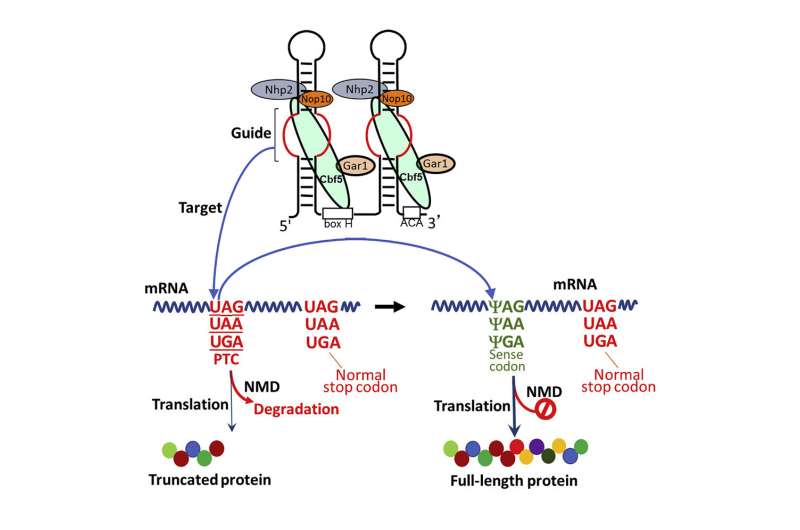This article has been reviewed according to Science X's editorial process and policies. Editors have highlighted the following attributes while ensuring the content's credibility:
fact-checked
peer-reviewed publication
trusted source
proofread
Scientists harness power, precision of RNA to make mutations invisible

Scientists have discovered a new way to suppress mutations that lead to a wide range of genetic disorders.
A study recently published in the journal Molecular Cell describes a strategy that co-opts a normal RNA modification process within cells to transform disease genes into normal genes that produce healthy proteins. The findings are significant because they may ultimately help researchers alter the course of devastating disorders such as cystic fibrosis, muscular dystrophy and many forms of cancer.
Negating nonsense
About 15% of mutations that lead to genetic diseases are called nonsense mutations. Aptly named, nonsense mutations occur when an mRNA molecule contains an early "stop" signal. When the mRNA takes genetic instructions from DNA to create a protein, this early stop sign orders the cell to stop reading the instructions partway through the process. This results in the creation of an incomplete protein that can lead to disease.
Led by Yi-Tao Yu, Ph.D., a team of researchers from the University of Rochester Center for RNA Biology designed an artificial guide RNA—a piece of RNA that can modify other types of RNA—to target mRNA molecules that contain early stop signals (also called premature termination codons). Guide RNAs are a natural mechanism that cells use all the time; Yu's team altered this already existing process.
Like DNA, RNA is made up of molecular building blocks that are represented by the letters A (adenine), G (guanine), U (uracil), and C (cytosine). Premature termination codons always have the building block U in the first position (for example, UAG, UAA or UGA). The team's artificial guide RNA was designed to modify the U in the first position, changing the molecular makeup of the targeted mRNA so that the stop signal is no longer—or less well—recognized by the cell.
The team, including Paul Boutz, Ph.D., assistant professor of Biochemistry and Biophysics; graduate students Yi Pan and Xueyang He; postdoctoral fellow Jonathan Chen; staff scientist Hironori Adachi; and researchers from ProQR Therapeutics tested the artificial guide RNA in yeast cells and in human disease cells (derived from cystic fibrosis and neurofibromatosis patients). In both cases, they found the action of the artificial guide RNA rendered the premature termination codon (stop sign) invisible, allowing cells to read the genetic instructions all the way through and create full-length, functional proteins.
They also discovered that the guide RNA suppressed another mechanism in the cell known as nonsense-mediated mRNA decay or NMD. One of the major surveillance systems in the body, NMD targets and eliminates mRNAs with premature termination codons, so no protein is produced. Curbing NMD is another way the artificial guide RNA ensured that a significant amount of mRNA was present in the cell, and that the genetic instructions carried by the targeted mRNAs were read all the way through and translated into complete proteins.
RNA route brings big benefits
Cystic fibrosis (CF) is one of many conditions that can result from a nonsense mutation. In CF, a nonsense mutation in the CFTR gene leads to the production of incomplete CFTR proteins, which are responsible for regulating the flow of salt and fluids in and out of cells. The result is the buildup of thick mucus and persistent lung infections that characterize the condition. Yu believes his team's strategy to suppress nonsense mutations in disease genes has great potential to help patients with CF and many other inherited genetic diseases.
"Our technique is promising because we didn't observe any negative, off-target effects. Using a single guide RNA in disease cells—and nothing else—we can specifically suppress nonsense mutations without disturbing other parts of the cell," noted Yu, dean's professor of Biochemistry and Biophysics at the University of Rochester School of Medicine and Dentistry. "There is always concern about specificity with gene therapies at the DNA level, because changes to DNA are permanent. Because RNA is transitory, there is less worry about long-lasting effects. RNA-guided RNA modification gives us tremendous power to zero in on one spot in the genome and make very precise changes."
"Dr. Yu's research is at the forefront of the most promising treatment modalities for cystic fibrosis and potentially other genetic diseases," said Jeffrey J. Hayes, Ph.D., chair and Shohei Koide Professor of Biochemistry and Biophysics at the University of Rochester School of Medicine and Dentistry. "These really are exciting times."
More information: Hironori Adachi et al, Targeted pseudouridylation: An approach for suppressing nonsense mutations in disease genes, Molecular Cell (2023). DOI: 10.1016/j.molcel.2023.01.009
Journal information: Molecular Cell
Provided by University of Rochester Medical Center





















